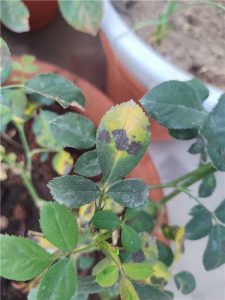Rose plants, often referred to as the “King of Flowers”, are highly prized for their beauty, fragrance and versatility. However, these rose plants are also vulnerable to several diseases, one of the most prevalent of which is blackspot. Blackspot is a fungal disease that affects roses, and it is one of the most widespread and damaging diseases in rose cultivation. Blackspot is a major concern for rose growers because it can significantly reduce the quality and yield of roses. In severe cases, blackspot can kill the plant entirely, resulting in significant financial losses for growers.
Blackspot is favoured by warm and humid conditions, with temperatures ranging between 20-30°C and relative humidity between 70-80%. Prolonged periods of leaf wetness due to heavy rainfall, overhead irrigation, or frequent morning dew also contribute to the development of the disease.
Type of Infestation
- The primary infection of black spot occurs in the spring and early summer, when the pathogen infects new growth on the plant.
- Secondary infections occur later in the season, as the pathogen spreads from infected leaves to healthy leaves. The pathogen can survive in the soil, on infected plant debris, or on the surface of the leaves, where it can infect new growth.
Scientific Name of Pathogen: Diplocarpon rosae
Most Affected States
Blackspot is a widespread disease in India and affects rose plants in many parts of the country. Some of the most affected states include Maharashtra, Karnataka, Tamil Nadu, West Bengal, and Uttar Pradesh.

Symptoms of Rose Black Spot
- Initially small, circular, black lesions appear on the upper surface of the leaves.
- As the disease progresses, the spots enlarge and become more numerous, and the leaves eventually become yellow and fall off.
- Due to defoliation, the plant’s overall health is significantly weakened, and its ability to produce flowers is greatly reduced.
Rose Black Spot Control Measures
Cultural Measures
Cultural practices are the first line of defense against blackspot. Some important practices include:
- Proper plant spacing: When planting roses, it is important to space plants at least 30 cm apart to allow for good air circulation.
- Water management: Watering roses at the base of the plant, rather than on the leaves, helps to prevent moisture from accumulating on the leaves and reduces the likelihood of blackspot infection.
- Crop Diversification: Crop diversification is an effective strategy for controlling blackspot. This involves growing a mix of different crops in the same field, which reduces the build-up of the pathogen and reduces the impact of the disease. For example, intercropping roses with vegetables, such as tomatoes or peppers, can help to control black spot.
- Use disease-resistant cultivars, as these plants are less susceptible to infection and can reduce the spread of the disease.
Mechanical Measures
- Collection and destruction of dead leaves on the ground can reduce the spread of blackspot disease in rose plants.
- Regular pruning of infected leaves also helps to reduce the spread of blackspot.
Biological Measures
- Biological control of blackspot involves the use of beneficial organisms to control the pathogen.
- Anand Dr Bacto’s Fluro Bio Fungicide contains an effective microbial culture Pseudomonas fluorescence which prevents the growth of target fungi. The recommended dosage is 2.5ml per liter of water.
Rose Black Spot Chemical Measures
In cases where cultural, mechanical and biological control strategies are not sufficient to control black spot, adoption of chemical method of control may be necessary. There are several fungicides available for controlling black spot in roses, including:
| Product Name | Technical Content | Dosage |
| Kavach Fungicide | Chlorothalonil 75% WP | 1-2 gm/liter water |
| Ridomil Gold Fungicide | Metalaxyl 4% + Manconzeb 64% WP | 1-1.5 gm/liter water |
| Kocide Fungicide | Copper Hydroxide 53.8% DF | 2 gm/liter water |
| Multiplex Neel Cu | Copper cheated with EDTA (12.0 %) | 0.5 gm/liter water |
| Indofil M45 Fungicide | Mancozeb 75% WP | 3-4 gm/liter water |
Explore Fighting Powdery Mildew In Roses-A Comprehensive Guide For Management And Control.





